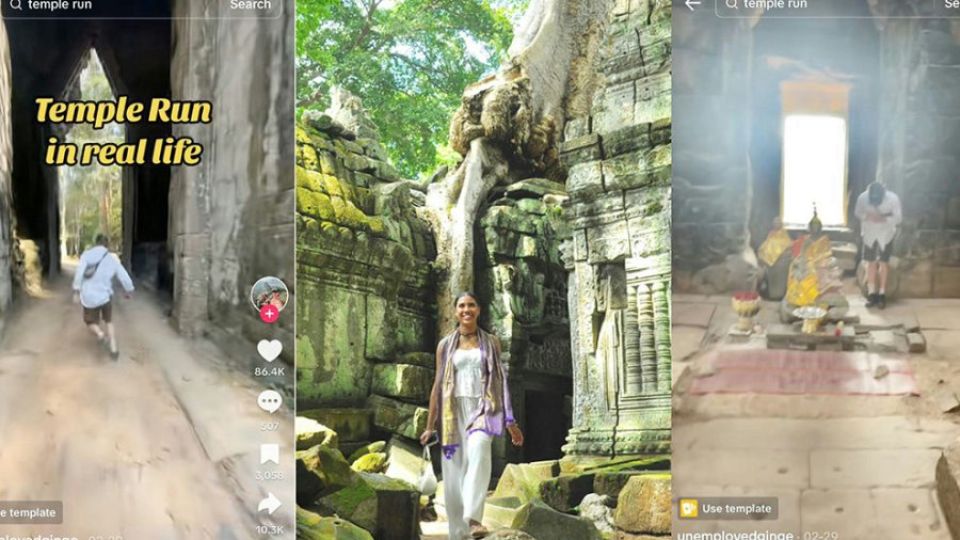August 29, 2024
PHNOM PENH – A new trend at Cambodia’s world-famous Angkor temples is sparking a lively debate among cultural anthropologists, as tourists increasingly embrace a real-life version of the popular mobile game Temple Run.
Inspired by the game, visitors are recording and sharing videos of themselves navigating the ancient ruins of Angkor Wat and Ta Prohm, blending modern technology with the rich cultural heritage of these historic sites.
This phenomenon has brought international attention to Cambodia’s tourism sector, highlighting the country’s ancient temples in a fresh and exciting way.
Temple Run, developed by Imangi Studios, is an endless runner game where players flee from demonic monkeys after stealing an idol from a temple.
The immersive experience of running through the dense jungle and ancient corridors at Angkor allows tourists to vividly imagine themselves as part of the game, adding a new layer of engagement to their visit.
The trend has gained significant traction on social media platforms such as TikTok, Facebook, and YouTube, where videos of tourists dashing down narrow stone paths and leaping across passageways – often accompanied by the iconic Temple Run soundtrack – have gone viral.
Cambodian Prime Minister Hun Manet has publicly expressed support for this trend, viewing it as a creative way to promote tourism.
“I have seen tourists filming Temple Run videos. They are doing it privately, but advertising us, which is not difficult,” he remarked, earlier this month.
“Foreign visitors come to our temples and post their videos on TikTok – not for business or on TV, but to promote our tourism industry. Let them do it; it’s okay,” he said.
However, the enthusiasm surrounding this trend is not without its critics. Cultural conservationists and several scholars are concerned about the potential risks posed by these activities.
The nearly thousand-year-old ruins at Angkor are delicate, and critics argue that the rush to capture social media content could lead to physical damage to the temples, while also diminishing their spiritual and cultural significance.
Simon Warrack, a conservationist with over three decades of experience working on the preservation of Angkor’s temples, voiced his concerns to the Bloomberg.
He was quoted as saying that, “You wouldn’t run through St. Peter’s in Rome or any Western church, so why is it acceptable to do so in Cambodia?”
Warrack emphasised that while the physical damage caused by such activities is a genuine concern, the disregard for the temples’ spiritual and cultural importance is equally troubling.
Leading a German-government-funded conservation project at Angkor Wat for 30 years, Hans Leisen didn’t hold back his feelings about the videos.
Leisen said “It’s nonsense,” according to the South China Morning Post.
“If you’re running through the temple, you won’t appreciate the beauty of the carvings. And if you fall or stumble, you might grab a wall to steady yourself, putting the fragile carvings at risk,” he continued.
The debate underscores a broader challenge faced by historic sites worldwide: balancing the benefits of increased tourism with the need for sustainable preservation.
This issue is particularly pressing in the post-Covid-19 era, where a surge in global travel, often referred to as “revenge travel,” has placed additional pressure on heritage sites.
Thuy Chanthuon, an associate professor of archaeology at the Royal Academy of Cambodia, offered a more measured perspective on the trend.
Chanthuon, who has extensive experience visiting historical sites throughout Southeast Asia, acknowledged that while the trend reflects a genuine interest in Khmer temples, there are legitimate concerns regarding safety and preservation.
“It’s fine if you run in soft rubber shoes that don’t strike the rocks hard,” Chanthuon noted, adding that his primary concern lies in the potential for accidents, given the uneven surfaces of the temple stones.
He also highlighted the importance of giving tourists the freedom to enjoy themselves, seeing it as part of showcasing Cambodia’s national heritage.
However, he cautioned that in some areas of the temples, running is simply not suitable due to the delicate nature of the structures.
The Apsara National Authority (ANA), which manages the Angkor Archaeological Park, has responded by promoting tourism while also ensuring the safety and preservation of the temples.
Long Kosal, a spokesman for the ANA, acknowledged that the “Temple Run” trend is beneficial for tourism growth, but urged visitors to exercise caution.
“The Temple Run trend is aimed at promoting tourism growth,” Kosal said, adding, “However, we urge our tourists to be careful, as some areas are elevated, and some surfaces are uneven, which can be dangerous. Please follow the Angkor Code of Conduct when visiting the Angkor resort.”
Sum Mab, secretary of state and spokesman for the Ministry of Culture and Fine Arts, echoed this sentiment, noting that the Ministry does not object to the filming of videos inspired by Temple Run.
He assured the public that inspections have shown no significant harm to the temples from these activities.
“Typically, camera operators film in areas where running is safe, and tourists are closely monitored by travel agents to ensure that no damage occurs,” Mab explained.
He also pointed out that unsafe areas are clearly marked with prohibition signs to prevent access.
The number of international tourists arriving in Cambodia has shown significant growth recently.
In the first semester of 2024, Cambodia welcomed 3,166,497 international tourists, marking a 22.7 per cent increase from the previous year, according to a June report on tourism statistics.


